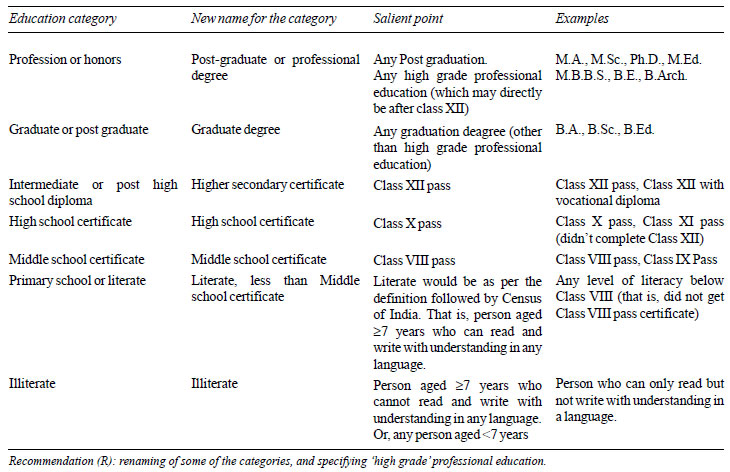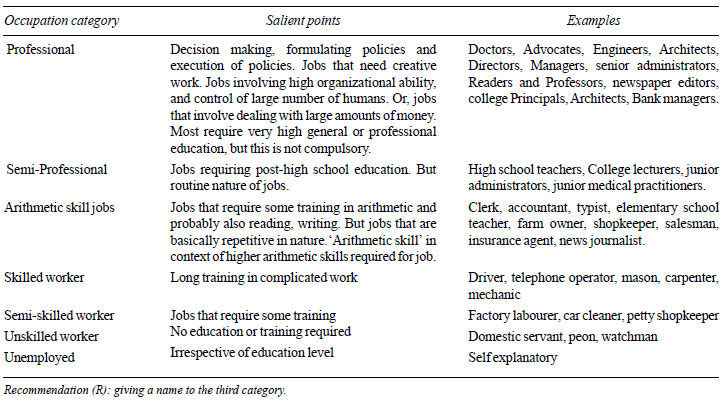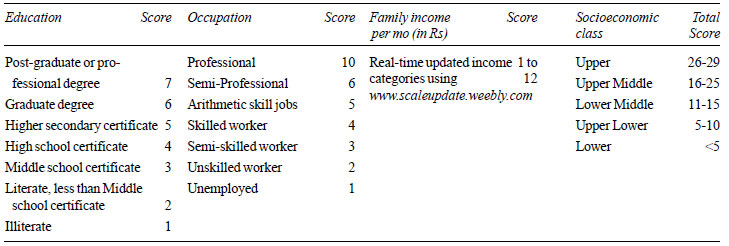he socio-economic status is
widely recognized as one of the important factors affecting the health
condition of an individual or a family [1]. Several studies done in
health-related fields require assessment of the socio-economic status
(SES) and consider it during the data analysis. The Kuppuswamy’s
Socioeconomic Status Scale is extensively used in urban population, for
assessment of the SES [2]. An online tool is available for real-time
updating of the scale [3]. Some of the facets of the scale sometimes
create confusion and require explanation on how to classify, and need
some minor updates to bring the scale up-to-date. These suggested
changes have implications on increasing the validity in use of this
popular SES tool.
Based upon explanations as per the details given in
the original scale and recommendations about the remaining points, this
article provides a revised scale that allows for the real-time update of
the scale. For the purpose of clarity, there is a symbol ‘(R)’ after
each point that is a recommendation, rather than explanation of the
original scale. The revised scale will retain its validity until the
time of revision of the method of calculation of the Consumer Price
Index – Industrial Workers (CPI-IW) or the baseline year for its
calculation.
Scoring of Education
1. Education of Head: The scoring is only
for the education of the Head of family, irrespective of whether
he/she was the subject or not.
2. Credit for completed milestone only:
The level of education to be considered should be the maximum level
already attained, not the one currently undergoing and not yet
completed. For example, a person currently in the second year of a
college degree course (of three years duration), has not completed
the graduation yet. So the allotted score for education should be 5
(‘higher secondary certificate’) only.
3. Renaming of categories: The education
scenario has changed since the time of the original scale. So, there
is a need for recommending few changes, than just clarifying the
existing categories. By and large, the concept of ‘intermediate’
after high school, has been replaced by ‘higher secondary’, that is
class XII (R).
4. ‘High grade’ professional degree: The
original scale mentions that the top most category of education
comprises of post-graduation as well as some courses that are
actually graduation but qualify to be the top most category if they
are ‘high grade’ professional degrees. The scale mentions few
examples of such courses but does not define. This revision
recommends that the following professional courses be included in
the topmost category and scored as 7: Engineering, Medical, Dental,
Architecture, and Chartered Accountancy (R).
5. Expanded definition of illiterate: The
current categorization includes all persons less than 7 years of age
as ‘illiterate’. As per the Census of India definition too, such
persons are treated as illiterate, irrespective of their actual
capacity to read and write [4]. The current definition has to be the
expanded one, to take into account the rare possibility of families
where Head may be less than 7 years of age. A hypothetical example
can be of two siblings, both less than 7 years of age, left orphaned
due to sudden unfortunate loss of their parents. Till the time of
their legal adoption by a relative or others, they would constitute
an ‘Electron family’[5]. For this family, the eldest sibling would
be the de-facto ‘head’ and education thus need to be scored.
Table I provides a description of the
Education categories.
|
TABLE I Explanation and Examples of
Classification of Education of Head of Family
|
 |
Scoring of Occupation
1. Occupation of Head: Remember that the
scoring is only for the occupation of the Head of family.
2. Retired Head: In case the Head of
family is currently retired, credit may be given while scoring for
his/her last job held (R).
3. How to score: While scoring an
individual, move up the categories from 1 to 10 score (that is from
‘unemployed’ upwards till ‘professional’). Moving up, decide the
maximum category to place the individual at and so the score that
can be allotted.
4. Independent scoring: The scoring of the
Occupation is independent of the scoring in the Education category.
Consider two hypothetical cases as examples – Case (a) A
lawyer who has never been employed ever, after attaining his/her
professional degree. There can be several reasons for such a
situation. The scoring for occupation should be 1 (for
‘unemployed’). Case (b) An architect by education, who is not
pursuing the profession fulltime or part time. (S) he has now opened
a cyber cafe shop and is occupied in running this shop. The scoring
should be for the third category of ‘Arithmetic skill jobs’
as per the actual status.
5. Name of third category: This has been a
source of some confusion. The original scale simply names this
category as ‘Clerical, Shop owner, Farm owner etc.’ that are just
examples of the category. It is explained in the original scale as
jobs that require some training in arithmetic and probably also
reading and writing. This revision recommends that this category be
named as ‘Arithmetic skill jobs’. The term ‘arithmetic
skill’ is used here in context of need of arithmetic skills in
the job (as given in the original scale) (R).
6. Shopkeeper classification: Many of the
people are likely to have this occupation, and the size of the shop
can also vary from a petty kiosk to a large popular store. It bears
noting that ‘shop keeper’ is actually being classified into two,
with ‘petty shopkeeper’- that is a small-time shopkeeper running
only a small shop, being classified lower as a ‘semi-skilled
worker’.
7. Ranking the prestige of an occupation:
As mentioned in the original scale, if a person shows greater
initiative than routine expected of his/her job, he/she can be
placed in a higher category of occupation.
Table II describes the Occupation
categories for clarification purpose. Note that just eliciting the
profession or designation of the head of the family may not be
enough, but details of the person’s actual occupation are required
in many occasions.
|
TABLE II Explanation and Examples of
Classification of Occupation of Head of the Family
|
 |
Scoring of Family Income
1. Family income, not per capita income:
It should be noted that the income to be assessed is total family
income (per month) and not the per capita income. This point has
been clarified earlier [3].
2. Real-time update: The income categories
to be used for the scale can be determined using the interactive
online calculator provided at www.scaleupdate. weebly.com .
3. CPI-IW value to use: The current or
latest value of CPI-IW may not be the one required always. For most
cross-sectional studies where an individual would be assessed for
SES only once, it would be the latest value available before the
data collection. The cut-off point can be considered as the printing
of study question-naires (or final freezing of study tool version,
in case of electronic data collection tools). For prospective
studies, where an individual is to be assessed at least six months
apart, different CPI-IW values can be used for real-time update as
applicable (R).
The Revised Kuppuswamy’s Socioeconomic Status Scale
with real-time update is detailed in the Table III. This
can be regarded as the latest version of the scale, and the real-time
update is dynamic, as per the calculations done using the online
interactive calculator at www.scaleupdate.weebly.com [3]. A
critical appraisal of the Kuppuswamy’s scale has been shared earlier
[1]. However, the scale has withstood the test of time and is still
widely used across studies in urban populations. This update is an
enhancement for increasing the scale’s validity for use in the current
times.
|
TABLE III Revised Kuppuswamy’s
Socioeconomic Status Scale with Real-time Update
|
 |
References
1. Sharma R, Saini NK. A critical appraisal of
Kuppuswamy’s socioeconomic status scale in the present scenario. J
Family Med Prim Care. 2014;3:3-4.
2. Kuppuswamy B. Manual of Socioeconomic Status
(Urban). Delhi:Manasayan;1981.
3. Sharma R. Online Interactive Calculator for
Real-time Update of the Kuppuswamy’s Socioeconomic Status Scale.
Available from: www.scaleupdate.weebly.com. Accessed June 01,
2017.
4. Office of the Registrar General & Census
Commissioner, India. Census of India 2011 – Metadata. Available from:
www.censusindia.gov.in/2011census/HLO/Metadata_ Census _2011.pdf.
Accessed June 01, 2017.
5. Sharma R. The family and family structure
classification redefined for the current times. J Family Med Prim Care.
2013;2:306-10.

